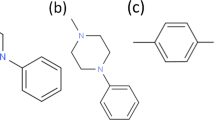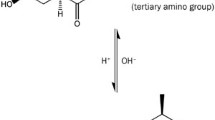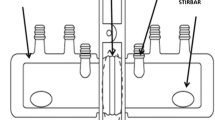Summary
-
1.
Jejunal loops of anaesthetized rats were perfused with hypotonic, isotonic and hypertonic buffered solutions containing 14C-labelled amidopyrine and antipyrine at neutral and at acidic pH. The blood flow of the loop was maintained at an intermediate rate (0.7–1.0 ml min−1g−1). The water net flux was determined by means of polyethylene glycol as non-absorbable marker and amounted up to ±30 μl min−1g−1.
-
2.
A positive water net flux (directed towards the blood) increased the appearance rate of amidopyrine and antipyrine by maximally 43.8 and 49.2%, a negative water net flux (directed towards the gut lumen) diminished it by 38.8 and 35.0%.
-
3.
The experimental data were analysed by means of a kinetic model with the water net flux as independent variable and the epithelial permeability kF D , the serosal permeability k S F S and the sieving coefficient Φ=1−σ as absorption parameters. For antipyrine independent of the pH-value of the perfusion solution kF D was 0.123, and, for amidopyrine at pH 7 and pH 3 kF D was 0.231 and 0.091, respectively. k S F S was zero indicating that in this experimental arrangement the transfer of drug molecules to the serosal side was negligible. The sieving coefficient Φ amounted to 2.30 for amidopyrine and 2.15 for antipyrine at neutral pH. At acidic pH it amounted to 0.50 for amidopyrine and 1.44 for antipyrine. The hydraulic permeability of water was identical at neutral and acidic pH.
-
4.
The high sieving coefficient for the two drugs at neutral pH is interpreted as indicating that water and lipophilic drug molecules interact within the lipid part of the cell membrane. At acidic pH the ionized drug molecules appear to permeate the cell membrane preferentially across other (presumably more hydrophilic) areas.
Similar content being viewed by others
References
Draper, N. R., Smith, H.: Applied regression analysis, 2nd ed. New York-London-Sidney: John Wiley and Sons, Inc. 1967
Fisher, R. B.: The absorption of water and of some small solute molecules from the isolated small intestine of the rat. J. Physiol. (Lond.) 130, 655–664 (1955)
Fordtran, J. S., Rector, F. C., Jr., Carter, N. W.: The mechanisms of sodium absorption in the human small intestine. J. clin. Invest. 47, 884–900 (1968)
Forth, W., Furukawa, E., Leopold, G., Rummel, W.: Vergleichende Untersuchungen über die Resorption 3H-markierter Herzglykoside. In: Radioisotope in Pharmakokinetik und klinischer Biochemie, pp. 123–128. Hrsg. G. Hoffmann u. H.-A. Ladner. Stuttgart-New York: Schattauer 1970
Geigy: Documenta Geigy: Wissenschaftliche Tabellen, 7. Aufl. Basel: J. R. Geigy 1968
Hakim, A. A., Lifson, N.: Urea transport across dog intestinal mucosa in vitro. Amer. J. Physiol. 206, 1315–1320 (1964)
Hanai, T., Haydon, D. A.: The permeability to water of bimolecular lipid membranes. J. theor. Biol. 11, 370–382 (1966)
Hechter, O.: Role of water structure in the molecular organization of cell membranes. Fed. Proc. 24, S 91–102 (1965)
Hogben, C. A. M., Tocco, D. J., Brodie, B. B., Schanker, L. S.: On the mechanism of intestinal absorption of drugs. J. Pharmacol. exp. Ther. 125, 275–282 (1959)
Katchalsky, A., Kedem, O.: Thermodynamics of flow processes in biological systems. Biophys. J. 2, Suppl. 53–78 (1962)
Kedem, O., Katchalsky, A.: Thermodynamic analysis of the permeability of biological membranes to non-electrolytes. Biochim. biophys. Acta (Amst.) 27, 229–246 (1958)
Kedem, O., Katchalsky, A.: A physical interpretation of the phenomenological coefficients of membrane permeability. J. gen. Physiol. 45, 143–179 (1961)
Kedem, O., Katchalsky, A.: Permeability of composite membranes. Trans. Faraday Soc. 59, 1918–1953 (1963)
Kunze, H., Vogt, W.: Resorption von Phenolrot aus dem Dünndarm der Ratte. Naunyn-Schmiedebergs Arch. Pharmak. exp. Path. 256, 139–148 (1967)
Levitt, D. G., Hakim, A. A., Lifson, N.: Evaluation of components of transport of sugars by dog jejunum in vivo. Amer. J. Physiol. 217, 777–783 (1969)
Lifson, N., Gruman, L. M., Levitt, D. G.: Diffusive-convective models for intestinal absorption of D2O. Amer. J. Physiol. 215, 444–454 (1968)
Lifson, N., Hakim, A. A.: Simple diffusiv-convective model for intestinal absorption of a nonelectrolyte (urea). Amer. J. Physiol. 211, 1137–1146 (1966)
Ochsenfahrt, H.: The mucosal-serosal transfer of drugs in the rat jejunum with and without blood flow. Naunyn-Schmiedebergs Arch. Pharmak. Suppl. 270, R 102 (1971)
Ochsenfahrt, H., Winne, D.: Der Einfluß der Durchblutung auf die Resorption von Arzneimitteln aus dem Jejunum der Ratte. Naunyn-Schmiedebergs Arch. Pharmak. 264, 55–75 (1969)
Ochsenfahrt, H., Winne, D.: Der Einfluß des Wassernettofluxes auf die Resorption von Arzneimitteln. Naunyn-Schmiedebergs Arch. Pharmak. 266, 414–415 (1970)
Ochsenfahrt, H., Winne, D.: The contribution of blood flow changes to solvent drag phenomenon. Life Sci. 11, Part 1, 1105–1113 (1972a)
Ochsenfahrt, H., Winne, D.: Solvent drag influence on the intestinal absorption of basic drugs. Life Sci. 11, Part 1, 1115–1122 (1972b)
Ochsenfahrt, H., Winne, D.: The contribution of solvent drag to the intestinal absorption of tritiated water and urea from the jejunum of the rat. Naunyn-Schmiedeberg's Arch. Pharmacol. 279, 133–152 (1973)
Osterhout, W. J. V., Murray, J. W.: Behavior of water in certain heterogeneous systems. J. gen. Physiol. 23, 365–390 (1940)
Schanker, L. S.: Physiological transport of drugs. Advanc. Drug Res. 1, 71–106 (1964)
Smulders, A. P., Wright, E. M.: The magnitude of nonelectrolytes selectivity in the gallbladder epithelium. J. Membr. Biol. 5, 297–318 (1971)
Stavermann, A. J.: The theory of measurement of osmotic pressure. Rec. Trav. chim. Pays-Bas 70, 344–352 (1951)
Tay, D. K. C., Findlay, G. P.: Permeability of the duodenum of the toad to non-electrolytes. Aust. J. biol. Sci. 25, 931–939 (1972)
Thau, G., Bloch, R., Kedem, O.: Water transport in porous and non-porous membranes. Desalination 1, 129–138 (1966)
Vogel, B., Becker, U., Ullrich, M.: The relevance of the osmolarity of the instillation fluid to the “effectiveness” and “toxicity” of drugs given by the intraduodenal route. Naunyn-Schmiedebergs Arch. Pharmacol. 277, Suppl., R 85 (1973)
Weast, R. C., Selby, S. M.: Handbook of chemistry and physics. 47th ed. Cleveland, Ohio: Chemical Rubber Publishing Co. 1966
Winne, D.: Die Pharmakokinetik der Resorption bei Perfusion einer Darmschlinge mit variabler Durchblutung. Naunyn-Schmiedebergs Arch. Pharmak. 268, 417–433 (1971)
Winne, D.: The influence of blood flow and water net flux on the absorption of tritiated water from the jejunum of the rat. Naunyn-Schmiedeberg's Arch. Pharmacol. 272, 417–436 (1972)
Winne, D., Ochsenfahrt, H.: Die formale Kinetik der Resorption unter Berücksichtigung der Darmdurchblutung. J. theor. Biol. 14, 293–315 (1967)
Winne, D., Remischovsky, J.: Der Einfluß der Durchblutung auf die Resorption von Harnstoff, Methanol und Äthanol aus dem Jejunum der Ratte. Naunyn-Schmiedebergs Arch. Pharmak. 268, 392–416 (1971a)
Winne, D., Remischovsky, J.: Der Einfluß der Durchblutung auf die Resorption von Polyalkoholen aus dem Jejunum der Ratte. Naunyn-Schmiedebergs Arch. Pharmak. 270, 22–40 (1971b)
Wright, E. M., Diamond, J. M.: An electrical method of measuring non-electrolyte permeability. Proc. roy. Soc. B 172, 203–225 (1969a)
Wright, E. M., Diamond, J. M.: Patterns of non-electrolyte permeability. Proc. roy. Soc. B 172, 227–271 (1969b)
Author information
Authors and Affiliations
Rights and permissions
About this article
Cite this article
Ochsenfahrt, H., Winne, D. The contribution of solvent drag to the intestinal absorption of the basic drugs amidopyrine and antipyrine from the jejunum of the rat. Naunyn-Schmiedeberg's Arch. Pharmacol. 281, 175–196 (1974). https://doi.org/10.1007/BF00503497
Received:
Issue Date:
DOI: https://doi.org/10.1007/BF00503497




